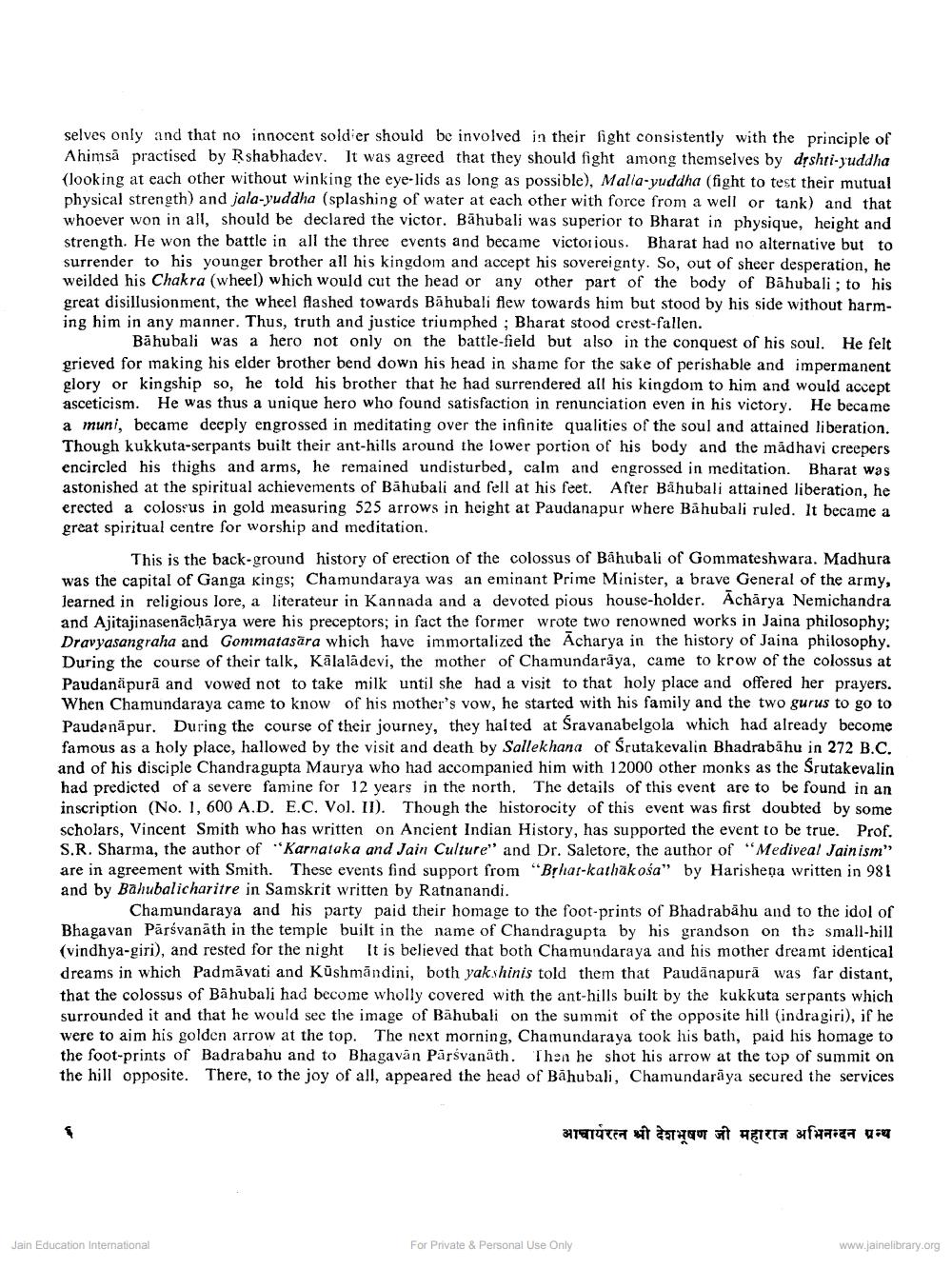________________
selves only and that no innocent soldier should be involved in their fight consistently with the principle of Ahimsă practised by Rshabhadev. It was agreed that they should fight among themselves by dệshti-yuddha (looking at each other without winking the eye-lids as long as possible), Malia-yuddha (fight to test their mutual physical strength) and jala-yuddha (splashing of water at each other with force from a well or tank) and that whoever won in all, should be declared the victor. Bāhubali was superior to Bharat in physique, height and strength. He won the battle in all the three events and became victorious. Bharat had no alternative but to surrender to his younger brother all his kingdom and accept his sovereignty. So, out of sheer desperation, he weilded his Chakra (wheel) which would cut the head or any other part of the body of Bahubali ; to his great disillusionment, the wheel flashed towards Bahubali flew towards him but stood by his side without harming him in any manner. Thus, truth and justice triumphed ; Bharat stood crest-fallen.
Bahubali was a hero not only on the battle-field but also in the conquest of his soul. He felt grieved for making his elder brother bend down his head in shame for the sake of perishable and impermanent glory or kingship so, he told his brother that he had surrendered all his kingdom to him and would accept asceticism. He was thus a unique hero who found satisfaction in renunciation even in his victory. He became a muni, became deeply engrossed in meditating over the infinite qualities of the soul and attained liberation. Though kukkuta-serpants built their ant-hills around the lower portion of his body and the madhavi creepers encircled his thighs and arms, he remained undisturbed, calm and engrossed in meditation. Bharat was astonished at the spiritual achievements of Bahubali and fell at his feet. After Bahubali attained liberation, he erected a colossus in gold measuring 525 arrows in height at Paudanapur where Bahubali ruled. It became a great spiritual centre for worship and meditation.
This is the back-ground history of erection of the colossus of Bahubali of Gommateshwara. Madhura was the capital of Ganga kings; Chamundaraya was an eminant Prime Minister, a brave General of the army, learned in religious lore, a literateur in Kannada and a devoted pious house-holder. Acharya Nemichandra and Ajitajinasenacharya were his preceptors; in fact the former wrote two renowned works in Jaina philosophy; Dravyasangraha and Gommatasara which have immortalized the Acharya in the history of Jaina philosophy. During the course of their talk, Kālalādevi, the mother of Chamundarāya, came to krow of the colossus at Paudanäpurā and vowed not to take milk until she had a visit to that holy place and offered her prayers. When Chamundaraya came to know of his mother's vow, he started with his family and the two gurus to go to Pauda nāpur. During the course of their journey, they halted at Sravanabelgola which had already become famous as a holy place, hallowed by the visit and death by Sallekhana of Sruta kevalin Bhadrabāhu in 272 B.C. and of his disciple Chandragupta Maurya who had accompanied him with 12000 other monks as the Srutakevalin had predicted of a severe famine for 12 years in the north. The details of this event are to be found in an inscription (No. 1, 600 A.D. E.C. Vol. II). Though the historocity of this event was first doubted by some scholars, Vincent Smith who has written on Ancient Indian History, has supported the event to be true. Prof. S.R. Sharma, the author of Karnataka and Jain Culture" and Dr. Saletore, the author of "Mediveal Jainism" are in agreement with Smith. These events find support from "Bịhar-kathakosa" by Harishena written in 981 and by Bahubalicharitre in Samskrit written by Ratnanandi.
Chamundaraya and his party paid their homage to the foot-prints of Bhadrabahu and to the idol of Bhagavan Pārsvanāth in the temple built in the name of Chandragupta by his grandson on the small-hill (vindhya-giri), and rested for the night It is believed that both Chamundaraya and his mother dreamt identical dreams in which Padmāvati and Kushmandini, both yakshinis told them that Paudānapurā was far distant, that the colossus of Bahubali had become wholly covered with the ant-hills built by the kukkuta serpants which surrounded it and that he would see the image of Bahubali on the summit of the opposite hill (indragiri), if he were to aim his golden arrow at the top. The next morning, Chamundaraya took his bath, paid his homage to the foot-prints of Badrabahu and to Bhagavan Parsvanath. Then he shot his arrow at the top of summit on the hill opposite. There, to the joy of all, appeared the head of Bāhubali, Chamundarāya secured the services
आचार्यरत्न श्री देशभूषण जी महाराज अभिनन्दन प्रन्थ
Jain Education International
For Private & Personal Use Only
www.jainelibrary.org




